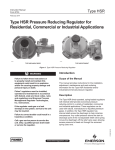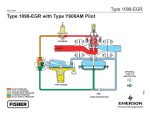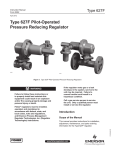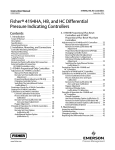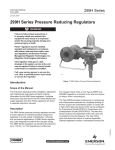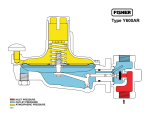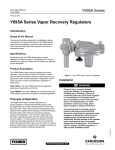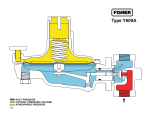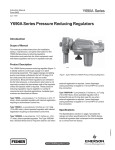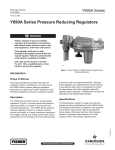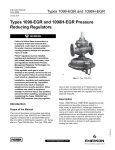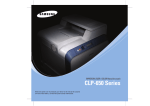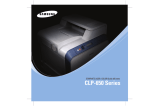Download Emerson Y600A Instruction Manual
Transcript
Y600A Series Instruction Manual Form 5458 December 2008 Y600A Series Pressure Reducing Regulators Introduction Scope of Manual This manual describes and provides instructions, installation, maintenance, and parts lists for Types Y600A, Y600AM, and Y600AR pressure regulators. Instructions and parts lists for other equipment used with these regulators are found in separate manuals. Product Description The Y600A Series pressure reducing regulators may be applied as switching valves, relay or pressure loading regulators, or monitoring regulator pilots, and are described as follows: Type Y600A—Direct-operated regulator with internal registration requiring no downstream control line. Type Y600AM—Direct-operated regulator with blocked throat, O-ring stem seal to prevent leakage around the stem, and diaphragm casing tapped 1/2-inch NPT for control line connection. Type Y600AR—Type Y600A with internal relief valve. Specifications Ratings and specifications for the Y600A Series regulators are given in the Specifications section on page 2. Individual regulator data is stamped on the closing cap as it comes from the factory. Installation ! Warning Figure 1. Type Y600A Pressure Regulator regulator is over pressured or is installed where service conditions could exceed the limits given in the Specifications section, or where conditions exceed any ratings of the adjacent piping or piping connections. To avoid such injury or damage, provide pressure-relieving or pressure-limiting devices (as required by the appropriate code, regulation, or standard) to prevent service conditions from exceeding those limits. Additionally, physical damage to the regulator could cause personal injury or property damage due to escaping gas. To avoid such injury or damage, install the regulator in a safe and well ventilated location. Regulator operation within ratings does not preclude the possibility of damage from debris in the lines or from external sources. A regulator should be inspected for damage periodically and after any overpressure condition. Key numbers referenced in this section are shown in Figures 3 through 6. D102511X012 Personal injury, property damage, equipment damage, or leakage due to escaping gas or bursting of pressurecontaining parts may result if this W7095 www.emersonprocess.com/regulators Y600A Series Specifications Body Sizes (Inlet x Outlet) and End Connection Style(1) 3/4 x 3/4 or 1 x 1-inch NPT Outlet Pressure Ranges(2) See Table 1 Flow Coefficients See Table 2 Maximum Inlet Pressure (Body Rating)(2) 150 psig (10,3 bar) Temperature Capabilities(2) –20° to 180°F (–29° to 82°C) Maximum Outlet Pressure (Casing)(2) 20 psig (1,38 bar) Spring Case Vent Connection 1/4-inch NPT Maximum Operating Inlet Pressure See Table 2 Diaphragm Case Connection 1/2-inch NPT Maximum Operating Outlet Pressure to Avoid Internal Parts Damage(2) 2 psig (0,14 bar) above outlet pressure setting Approximate Weight 13 pounds (5,9 kg) 1. End connections for other than U.S. standards can usually be provided; consult your local Sales Office. 2. The pressure/temperature limits in this instruction manual and any applicable standard or code limitation should not be exceeded. Table 1. Outlet (Control) Pressure Ranges Type number Y600A, Y600AM, Y600AR approximate point above pressure setting at which THE type y600ar internal relief starts to discharge spring color spring part number outlet pressure range with spring case above diaphragm(1) Red 1B653827052 Olive drab 1B653927022 Yellow 1B537027052 Light green 1B537127022 1.2 to 2.5 psig (0,08 to 0,17 bar) 0.5 to 2 psig (0,03 to 0,14 bar) Light blue 1B537227022 2.5 to 4.5 psig (0,17 to 0,31 bar) 0.5 to 3 psig (0,03 to 0,21 bar) Black 1B537327052 4.5 to 7 psig (0,31 to 0,48 bar) 1 to 4 psig (0,07 to 0,28 bar) 4 to 8-inches w.c. (10 to 20 mbar) 7 to 16-inches w.c. (17 to 40 mbar) 15-inches w.c. to 1.2 psig (37 to 83 mbar) 10 to 24-inches w.c. (25 to 60 mbar) 10 to 26-inches w.c. (25 to 65 mbar) 1. Minimum outlet pressure setting may be approximately 1-inch w.c. (2 mbar) lower if spring case is below diaphragm. Table 2. Maximum Operating Inlet Pressures wide-open FLOW COEFFICIENTS for external relief sizing Maximum operating inlet pressure, psig (bar) Orifice size, inches (mm) With 1.2 Psig (0,08 bar) or Less Outlet Pressure Setting With 1.2 to 2.5 Psig (0,08 to 0,17 bar) Outlet Pressure Setting With 4.5 to 7 Psig (0,31 to 0,48 bar) Outlet Pressure Setting cg Cv C1 1/8 (3,17) 150 (10,3) 150 (10,3) 150 (10,3) 150 (10,3) 12.3 0.35 35 3/16 (4,76) 150 (10,3) 150 (10,3) 150 (10,3) 150 (10,3) 27.6 0.79 35 1/4 (6,35) 75 (5,17) 150 (10,3) 150 (10,3) 150 (10,3) 50 1.43 35 3/8 (9,53) 35 (2,41) 60 (4,14) 60 (4,14) 60 (4,14) 110 3.14 35 1/2 (12,7) 8 (0,55) 10 (0,69) 12 (0,83) 12 (0,83) 200 5.71 35 9/16 (14,3) 5 (0,34) 6 (0,41) 8 (0,55) 8 (0,55) 250 7.14 35 Note If the regulator is shipped mounted on another unit, install that unit according to the appropriate instruction manual. 2 With 2.5 to 4.5 Psig (0,17 to 0,31 bar) Outlet Pressure Setting 1. Only personnel qualified through training and experience should install, operate, and maintain a regulator. For a regulator that is shipped separately, make sure that there is no damage to, or foreign material in the regulator. Also ensure that all tubing and piping are free of debris. Y600A Series 2. The regulator may be installed in any position as long as the flow through the body is in the direction indicated by the arrow cast on the body. If continous operation is required during inspection or maintenance, install a three-valve bypass around the regulator. ! Warning A regulator may vent some gas to the atmosphere. In hazardous or flammable gas service, vented gas may accumulate and cause personal injury, death, or property damage due to fire or explosion. Vent a regulator in hazardous gas service to a remote, safe location away from air intakes or any hazardous area. The vent line or stack opening must be protected against condensation or clogging. 3. Be certain that the vent (key 26) is not positioned so that it can collect moisture which may drain into the spring case. The diaphragm casing (key 4) may be rotated to any of four positions with respect to the body in order to obtain desired positioning. Perform Body Area Maintenance procedure steps 1 and 4 through 8 to rotate the diaphragm casing. 4. The Type Y600AM regulator requires a downstream control line. Be sure to install this control line before putting the regulator into operation. The downstream control line pipe should be at least 1/2-inch (12,7mm) in diameter and connected to a straight section of outlet piping at least 5 to 10 pipe diameters downstream of the regulator. If instability due to turbulence exists, a hand valve can be installed in a straight section of the control line. This hand valve can be throttled down to dampen out pulsations. Startup and Adjustment A Y600A Series regulator can be placed in operation by slowly introducing inlet pressure. The regulator takes control when downstream pressure is established. The regulator has been adjusted at the factory to provide approximately the reduced pressure requested on the order. With a spring-loaded regulator, the pressure setting may be adjusted within the spring range shown in Table 1. To adjust the pressure setting, perform the following steps (key numbers are referenced in Figures 3 through 6): 1. Remove the closing cap (key 22). 2. Use a 1-inch (25,4 mm) hex rod or screwdriver to turn the adjusting screw (key 35) either clockwise to increase outlet pressure or counterclockwise to decrease outlet pressure. ! Warning To avoid personal injury, property damage, or equipment damage caused by bursting of pressure containing parts or explosion of accumulated gas, never adjust the control spring to produce an outlet pressure higher than the upper limit of the outlet pressure range for that particular spring. If the desired outlet pressure is not within the range of the control spring, install a spring of the proper range according to the Diaphragm and Spring Case Area section of the Maintenance procedure. 3. After making the adjustment and replacing the closing cap (key 22), the closing cap can be wired to the spring case (key 3) to discourage tampering. Shutdown First close the nearest upstream shutoff valve and then close the nearest downstream shutoff valve to vent the regulator properly. Next, open the vent valve between the regulator and the downstream shutoff valve closest to it. All pressure between these shutoff valves is released through the open vent valve, since a Y600A Series regulator remains open in response to the decreasing downstream pressure. Maintenance Regulator parts are subject to normal wear and must be inspected and replaced as necessary. The frequency of inspection and replacement of parts depends on the severity of service conditions and upon applicable codes and government regulations. Key numbers are referenced in Figures 3 through 5 unless otherwise noted. ! Warning To avoid personal injury, property damage, or equipment damage caused by sudden release of pressure or explosion of accumulated gas, do not attempt any maintenance or disassembly without first isolating the regulator from system pressure and relieving all internal pressure from the regulator. 3 Y600A Series Body Area This procedure is for gaining access to the disk assembly, orifice, body O-ring, and pitot tube if used. All pressure must be released from the diaphragm casing, and the disk assembly must be open, before these steps can be performed. BODY SEAL o-ring (Key 11) Backup ring (Key 48) Body (Key 1) 1. Remove the cap screws (key 2) and separate the diaphragm casing (key 4) from the body (key 1). 2. Remove and inspect the body seal O-ring (key 11) and the backup ring (key 48). See Figure 2. 3. Inspect and replace the orifice (key 5) if necessary. Protect the orifice seating surface during disassembly and assembly. Lubricate the threads of the replacement orifice with a good grade of light grease and install with 29 to 37 foot-pounds (39 to 50 N•m) of torque. 4. To replace the disk assembly (key 13), remove the cotter pin (key 15). If not necessary, skip to step 7. 5. To replace the pitot tube (key 32, Figures 3 and 6) on the Types Y600A and Y600AR, remove the machine screws (key 33), install the new pitot tube, and secure with the machine screws. Position the pitot tube so that it points into the outlet of the body (key 1) by rotating the guide insert (key 18). 6. Install the disk assembly (key 13) and secure it with the cotter pin (key 15). 7. Place backup ring (key 48) into the body (key 1). Then place the body seal O-ring (key 11) into the body. See Figure 2. 8. Place the diaphragm casing (key 4) on the body (key 1). Secure the the diaphragm casing to the body with the cap screws (key 2) using 7 to 9 foot-pounds (9 to 12 N•m). Diaphragm and Spring Case Area This procedure is for gaining access to the spring, diaphragm, lever assembly stem, and Type Y600AM stem O-ring. All pressure must be released from the diaphragm casing before performing these steps. Note Any Type 662 remote control drive unit used with a Y600A Series regulator must be removed from the spring case (key 3) before these steps can be performed. 4 Figure 2. Expanded View of the Body Area Showing the Body Seal O-ring and Backup Ring Placement 1. Remove the closing cap (key 22), and turn the adjusting screw (key 35) counterclockwise to remove the compression from the spring (key 6). 2. If the only maintenance is to change the control spring, take out the control spring and replace with the desired spring. Turn the adjusting screw (key 35) clockwise to compress the spring to the desired outlet pressure setting. Skip to step 11. 3. If further maintenance to the internal diaphragm casing parts is required, remove the hex nuts (key 23, not shown) and cap screws (key 24). Remove the diaphragm (key 10) plus attached parts by tilting them so that the pusher post (key 8) slips off the lever assembly (key 16). To separate the diaphragm from the attached parts, unscrew the cap screw (key 38, Figures 3 and 4) from the pusher post (key 8) for a Type Y600A or Y600AM, or unscrew the relief valve spring holder (key 37, Figure 6) from the pusher post (key 8) for a Type Y600AR. If the only further maintenance is to replace the diaphragm parts, skip to step 7. 4. To replace the lever assembly (key 16), remove the machine screws (key 17). To replace the stem (key 14) or the Type Y600AM stem O-ring (key 30, Figure 4), also perform Body Area Maintenance procedure steps 1 and 4, and pull the stem (key 14) out of the diaphragm casing (key 4). With a Type Y600AM, grease the replacement stem O-ring (key 30, Figure 4) with a good grade of lubricant and install it on the tem (key 14). 5. Install the stem (key 14) into the diaphragm casing (key 4) and perform Body Area Maintenance procedure steps 6 through 8 as necessary. Y600A Series 6. Install the lever assembly (key 16) into the stem (key 14) and secure the lever assembly with the machine screws (key 17). 7. For a Type Y600A or Y600AM (Figures 3 and 4), hold the pusher post (key 8) and place diaphragm assembly parts on the pusher post in the following order: diaphragm (key 10), diaphragm head (key 7), lower spring seat (key 50), and washer (key 36), and secure with diaphragm cap screw (key 38) using 7 to 9 foot-pounds (9 to 12 N•m) of torque or for a Type Y600AR (Figure 6), secure the pusher post (key 8) to the relief valve spring holder with 1 to 3 foot-pounds (1,4 to 4,1 N•m) of torque. 8. Install the pusher post (key 8) and attached parts onto the lever (key 16). 9. Install the control spring (key 6) and spring case (key 3) on the diaphragm casing (key 4) so that the vent assembly (key 26) is correctly oriented, and secure them with the cap screws (key 24) and hex nuts (key 23) to finger tightness only. 10. Turn the adjusting screw (key 35) clockwise until there is enough control spring (key 6) force to provide proper slack to the diaphragm (key 10). Using a crisscross pattern, finish tightening the cap screws (key 24) and hex nuts to 5 to 6 foot-pounds (6,8 to 8,1 N•m) of torque. Finish turning the adjusting screw to the desired outlet pressure setting. 11. Install the closing cap (key 22) or the Type 662 remote control drive unit, if used. To Convert Constructions The Type Y600A to the Type Y600AM: New parts required: keys 30, 31, and 33 1. Remove pipe plug (key 27) from the diaphragm casing (key 4). 2. Refer to steps 1 and 5 in the Body Area Maintenance section to remove the four machine screws (key 33) and pitot tube (key 32, Figure 3). 3. Insert the throat O-ring (key 31, Figure 4) and one machine screw (key 33, Figure 4). 4. Insert the stem O-ring (key 30, Figure 4) by following steps 1 through 6 in the Diaphragm and Spring Case Area Maintenance section. The Type Y600AM to the Type Y600A: New parts required: keys 27, 32, and 33 1. Insert pipe plug (key 27, Figure 4) in the diaphragm casing (key 4). 2. Follow steps 1 through 4 in the Diaphragm and Spring Case Area Maintenance section to remove one machine screw (key 33, Figure 3), the stem seal O-ring (key 30, Figure 4), and the throat seal (key 31, Figure 4) blocking the registration port. 3. Insert pitot tube (key 32) and four machine screws (key 33) as outlined in step 5 of the Body Area Maintenance section. Parts Ordering When corresponding with your local Sales Office about this regulator, include the type number and all other pertinent information stamped on the closing cap. Specify the eleven-character part number when ordering new parts from the following parts list. Parts List (Figures 3 through 6) Key Description Parts Kit (keys 10, 11, 12, 13, 15, 30, and 31) Types Y600A and Y600AM Type Y600AR 1 Body, Cast iron 3/4 x 3/4-inch 1 x 1-inch 2 Cap Screw (2 required), Plated steel 3 Spring Case Assembly, Cast iron 4 Diaphragm Casing, Cast iron 5 Orifice, Aluminum 1/8-inch (3,18 mm) 3/16-inch (4,76 mm) 1/4-inch (6,35 mm) 3/8-inch (9,53 mm) 1/2-inch (12,7 mm) 9/16-inch (14,3 mm) 6 Spring, Plated steel 4 to 8-inches w.c. (10 to 20 mbar) 7 to 16-inches w.c. (17 to 40 mbar) 15-inches w.c. to 1.2 psig (37 to 83 mbar) 1.2 to 2.5 psig (0,08 to 0,17 bar) 2.5 to 4.5 psig (0,17 to 0,31 bar) 4.5 to 7 psig (0,31 to 0,48 bar) 7 Diaphragm Head Types Y600A and Y600AM, 304 Stainless steel Type Y600AR, Plated steel 8 Pusher Post Types Y600A and Y600AM, Aluminum Type Y600AR, Zinc 10* Diaphragm, Nitrile (NBR) Types Y600A and Y600AM Type Y600AR 11* Body Seal O-ring, Nitrile (NBR) 12* Insert Seal O-ring, Nitrile (NBR) 13* Disk Assembly, Aluminum Disk Holder with Nitrile (NBR) disk 14 Stem, Stainless Steel 15* Cotter Pin, Stainless steel Part Number RY600AX0012 RY600ARX012 1E987119012 1E987319012 1C856228992 1B6365X0342 47B2271X012 1A936709012 00991209012 0B042009012 0B042209012 1A928809012 1C4252X0012 1B653827052 1B653927022 1B537027052 1B537127022 1B537227022 1B537327052 17B9723X032 1B541425072 17B9734X032 2B541944012 17B9726X012 1C942902072 1H993806992 1B885506992 1C4248X0212 17B3423X012 1A866537022 * Recommended spare part. 5 Y600A Series A7141_1 Figure 3. Type Y600A Regulator Assembly Key Description 16 Lever Assembly, Plated steel 17 Machine Screw (2 required), Stainless steel 18 Guide Insert, Delrin 22 Closing Cap, Thermoplastic 23 Hex Nut, not shown (8 required), Plated steel 24 Cap Screw (8 required), Plated steel 26 Type Y602 Vent Assembly Spring case up (standard) Spring case down 27 Pipe Plug, Plated steel (Types Y600A and Y600AR only) 30* Stem O-Ring (Type Y600AM only), Nitrile (NBR) 31* Throat Seal O-Ring (Type Y600AM only), Nitrile (NBR) * Recommended spare part. 6 Part Number 1B5375X0082 19A7151X022 27B4028X012 T13524T0062 1E985324142 T1070824912 17A5515X012 17A6570X012 1A369224492 1H292606992 1D682506992 Key Description 32 Pitot Tube (Types Y600A and Y600AR only), 304 Stainless steel 33 Machine Screw, Stainless steel Type Y600AM (1 required) Types Y600A and Y600AR (4 required) 35 Adjusting Screw, Zinc 36 Washer 37 Spring Holder (Type Y600AR only), Plated steel 38 Diaphragm Cap Screw (Types Y600A and Y600AM only), Plated steel 39 Relief Valve Spring (Type Y600AR only), Plated steel 48 Back Up Ring, Stainless Steel 50 Lower Spring Seat (Types Y600A and Y600AM only), Plated steel Part Number 17B4479X012 18A0703X022 19A7151X022 1B537944012 18B3440X012 1C323114012 1B290524052 1B541327022 18B3446X012 1B636325062 Y600A Series A7142_1 Figure 4. Type Y600AM Regulator Assembly 2 A7144 Figure 5. Diaphragm Casing Cap Screw Location 7 Y600A Series 48 A7143 Figure 6. Type Y600AR Regulator Assembly Industrial Regulators Natural Gas Technologies TESCOM Emerson Process Management Regulator Technologies, Inc. Emerson Process Management Regulator Technologies, Inc. Emerson Process Management Tescom Corporation USA - Headquarters McKinney, Texas 75069-1872 USA Tel: 1-800-558-5853 Outside U.S. 1-972-548-3574 USA - Headquarters McKinney, Texas 75069-1872 USA Tel: 1-800-558-5853 Outside U.S. 1-972-548-3574 USA - Headquarters Elk River, Minnesota 55330-2445 USA Tel: 1-763-241-3238 Asia-Pacific Shanghai, China 201206 Tel: +86 21 2892 9000 Asia-Pacific Singapore, Singapore 128461 Tel: +65 6777 8211 Europe Bologna, Italy 40013 Tel: +39 051 4190611 Europe Bologna, Italy 40013 Tel: +39 051 4190611 Gallardon, France 28320 Tel: +33 (0)2 37 33 47 00 Middle East and Africa Dubai, United Arab Emirates Tel: +971 4811 8100 Europe Selmsdorf, Germany 23923 Tel: +49 (0) 38823 31 0 For further information visit www.emersonprocess.com/regulators The Emerson logo is a trademark and service mark of Emerson Electric Co. All other marks are the property of their prospective owners. Fisher is a mark owned by Fisher Controls, Inc., a business of Emerson Process Management. The contents of this publication are presented for informational purposes only, and while every effort has been made to ensure their accuracy, they are not to be construed as warranties or guarantees, express or implied, regarding the products or services described herein or their use or applicability. We reserve the right to modify or improve the designs or specifications of such products at any time without notice. Emerson Process Management does not assume responsibility for the selection, use or maintenance of any product. Responsibility for proper selection, use and maintenance of any Emerson Process Management product remains solely with the purchaser. ©Emerson Process Management Regulator Technologies, Inc., 1999, 2008; All Rights Reserved









